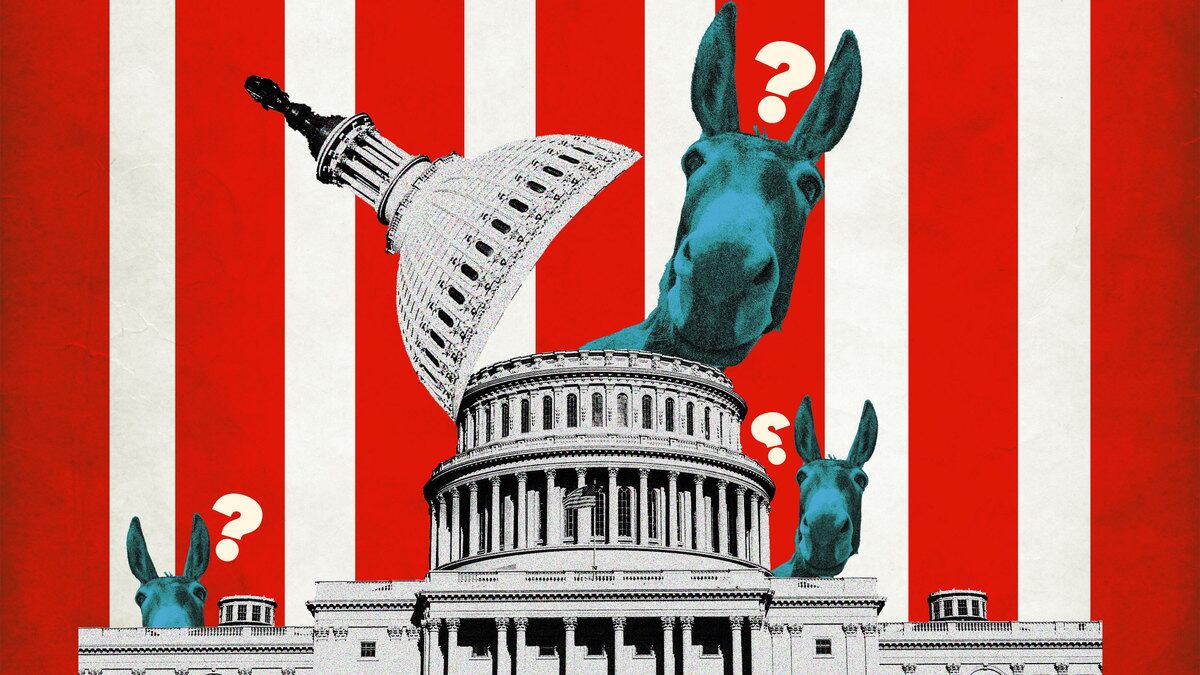Ask 10 Democratic lawmakers what their top legislative priority should be if they control Congress next year, and you’ll get 10 different answers.
Sen. Chris Murphy (D-CT), for instance, said protecting abortion rights was “obviously at the top of my agenda next year.”
Sen. Brian Schatz (D-HI) referenced the party’s economic agenda, saying Democrats “have to keep fighting to lower the cost of living for people,” which he called “our No. 1 priority.”
ADVERTISEMENT
Meanwhile, Sen. Bob Casey (D-PA) pointed to “unfinished business”—namely, provisions that fell out of Democrats’ ambitious Build Back Better agenda this session—like home- and community-based services for seniors and the disabled.
Sen. Chris Van Hollen (D-MD) said the party’s top legislative priority should be “enact[ing] the provisions to protect our democracy more fully.”
Sen. John Hickenlooper (D-CO) said Democrats should think about climate change “holistically” and develop “an actionable plan from now for the next 40 years.”
Rep. Tim Ryan (D-OH), who’s running for U.S. Senate, called for a “permanent working-class tax cut” to be the party’s top priority.
Clearly, there are plenty of things Democrats still want to do after spending two years in control of Congress—a stretch that saw them make good on a number of campaign promises, from passing reforms aimed at lowering the cost of prescription drugs to making a historic investment in fighting climate change.
Most lawmakers would agree that the goals expressed on the economy, abortion, democracy, and climate are all worthy of pursuit. But in the eyes of some in Democratic politics, the wide-ranging visions of a forward-looking legislative agenda show that the party isn’t having enough of a conversation about what, exactly, it would do with the majorities it is campaigning so hard to win.
That may not be a pressing political problem in the 2022 campaign, as Democrats largely run on their records and make the case against Republican governance. But it could spell trouble later on, some worry.
“There’s not a clear legislative agenda, no consensus around what’s next,” said Lindsay Owens, executive director of Groundwork Collaborative, a progressive nonprofit. “It’s not a fatal weakness politically; on the policy side, it’s malpractice.”
That lack of clarity isn’t satisfying Ryan, who is aiming to flip a Senate seat in increasingly conservative Ohio this fall. Asked if Democrats were being explicit enough with voters about what they would do with another two years in power, he simply said “no.”
“Frankly, it pisses me off to see Democrats get caught up in stupid fights rather than do the urgent work to protect the rights of all Americans and make sure we can compete with countries the world over and dominate the industries of the future,” Ryan said, through a campaign spokesperson.
The disparate nature of Democrats’ visions is, on some level, understandable. Several of the lawmakers asked by The Daily Beast about a 2023 agenda emphasized that they were completely focused on winning November’s elections.
Some lawmakers are not terribly worried about an agenda snapping into place, should they get the chance to enact it. “This will not be a dog-catches-car situation where we don’t know what to do,” Rep. Jared Huffman (D-CA) told The Daily Beast.
According to a senior Democratic aide, there is ongoing talk among members to shape a potential majority agenda next year. “There are still things members wish they’d gotten done this Congress and want to get done,” the aide said.
Still, a few Democrats seemed surprised to have even been asked what they might do if those elections went their way. “People are tired, understaffed, and under-resourced,” said one source in the party. “We just did a huge amount in the last two years…. ambitions are not high. People are not like, ‘let’s double down.’”
Considering another two years of Democratic control on Capitol Hill is hardly an academic exercise. While a sweep of Congress remains a tall order for Democrats, their outlook is better than it was a year ago, and lawmakers and operatives are growing increasingly bullish about their chances in November.
According to FiveThirtyEight’s latest projections, Democrats currently have a 2-out-of-3 shot of holding the Senate, and a 1-out-of-3 chance of holding the House. A scenario where both occur is unlikely, but not out of the question.
To some Democrats, the more important question is not if they keep the Senate majority, but how many seats they win. If they win 52, they likely would have enough support to end the filibuster, the Senate’s 60-vote threshold for passing most bills. That move would allow Democrats to turn most of their biggest stymied dreams—on voting rights, protecting abortion access, and more—into reality.
With Democrats arguably having accomplished as much as they could in a caucus that includes both Sens. Joe Manchin (D-WV) and Kyrsten Sinema (D-AZ), some lawmakers are not especially enthused at the prospect of a rerun of the last two years of painstaking negotiations involving the pair.
“If we hold a House majority, and get two more senators so that Manchin and Sinema are not the gatekeepers of all the good things we’d like to do, it’s a pretty exciting scenario,” Huffman said. A repeat of a 50-50 Senate, he added, would be “pretty unsatisfying.”
In that scenario, Democrats would have to turn again to the process known as budget reconciliation, which allowed them to advance the sweeping Inflation Reduction Act this year and the $1.9 trillion American Rescue Plan in 2021 with a simple majority vote. The filibuster-circumventing process applies only to bills with a specific budgetary impact, excluding long-awaited items like immigration or election reform.
Every Democratic lawmaker and aide contacted by The Daily Beast agreed that the reconciliation process would be used again if they held the House and Senate. The senior Democratic aide, speaking anonymously to candidly describe internal conversations, said it was “very possible that you’d see another IRA-sized bite at the apple.”
But ideas vary as to what, exactly, Democrats would stuff in another reconciliation package. Many would like to see a renewal of the child tax credit, a significant monthly subsidy for families that was approved in the ARP but expired in December 2021. There remains plenty of support for other social safety net priorities that were once part of the Build Back Better bill but did not make it into the IRA, like universal pre-K and paid family leave.
“We haven’t gotten to the point of timing or scheduling, but there’s a long list of issues we’d like to get to, which really speak to real life, real families, struggling with affordability of childcare, or lack of home care options,” said Casey, who was a lead proponent of home care provisions in the BBB plan.
Sen. Chris Coons (D-DE), a close ally of Biden, said that the president’s agenda is one “that deserves continued robust, Democratic support, meeting the costs and needs of working families across the country.” He laid out less sweeping but more targeted actions a Democratic majority could take, like boosting workforce training to create jobs and speed construction projects fueled by the $1 trillion infrastructure law passed in 2021.
Incoming members have also laid down their visions for a reconciliation package. Greg Casar, a progressive Democrat who is almost certain to represent Texas in the U.S. House next year, told The Daily Beast that he would push for “ambitious legislation to provide universal paid family leave, free community college, raising the minimum wage, and comprehensive immigration reform.”
“We should abolish the filibuster and pass these laws immediately,” Casar said, “or ensure that we can get these important policies into reconciliation.”
In making their midterm case, Republicans have attacked Democrats’ ambitious, big-spending bills and argued they would do more of the same if given another turn in the majority.
The party out of power is typically more explicit about campaigning on governing plans: in 2006, for instance, House Democrats made a number of promises about what specific bills they’d pursue if voted into the majority.
In 2022, congressional Republicans have largely abandoned any pretense of laying out an agenda. Senate Minority Leader Mitch McConnell (R-KY) has explicitly rejected the idea of crafting one, especially after Sen. Rick Scott (R-FL), his campaign chief, released his own plan that was widely panned. In September, House Minority Leader Kevin McCarthy (R-CA) rolled out a House GOP platform titled “Commitment to America,” but it’s light on any specific legislative promises.
But the 2022 midterm has become an unexpected referendum on one key Republican agenda item: rolling back abortion rights. The Supreme Court’s overturning of Roe v. Wade in June caused widespread backlash among voters and has prompted Democratic candidates to seize on the issue in hopes of capitalizing on that backlash.
If that groundswell helps Democrats keep and expand their majorities, congressional aides acknowledge that they would need to prioritize legislation to codify protection of abortion access into law.
Activists like Leah Greenberg, co-founder of the influential progressive group Indivisible, are already making that point.
“If Democrats win expanded majorities including 52 seats, it will be a clear rejection of MAGA Republicans’ extremism and assault on our democracy,” Greenberg said. “Democrats must honor that mandate with an immediate move to end the filibuster to protect our freedoms and democracy, immediately passing structural democracy reform and ensuring the right to abortion access nationally,” she said.
Some Democrats argue that the party can and should be clearer with voters about their policy plans for the majority. Owens, of Groundwork Collaborative, pointed to John Fetterman—the Democratic nominee for Senate in Pennsylvania—as someone who has put forward a compelling and distinctive pitch focused on how a Democratic majority might rein in corporate abuses to lower costs.
But to some key figures in the party, the strongest message that Democrats can send about their potential priorities next year has already been sent through the party’s legislative record—not just the IRA, but the passage of the infrastructure law and the so-called CHIPS Act, which invests tens of billions of dollars in U.S. high-tech manufacturing.
“I think you can see where our focus is, right?” Murphy said. “Our focus is on covering the cost of health care and re-industrializing America. So if you’re concerned about bringing manufacturing jobs back to the United States, if you're concerned about the amount of money you’re paying for health care, then we’ve shown this summer that we can deliver.”









